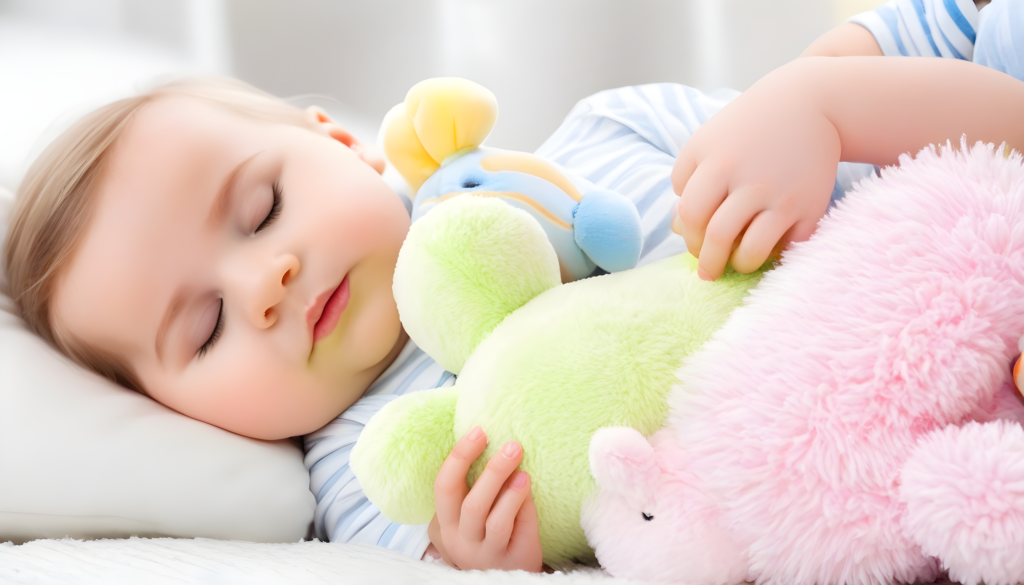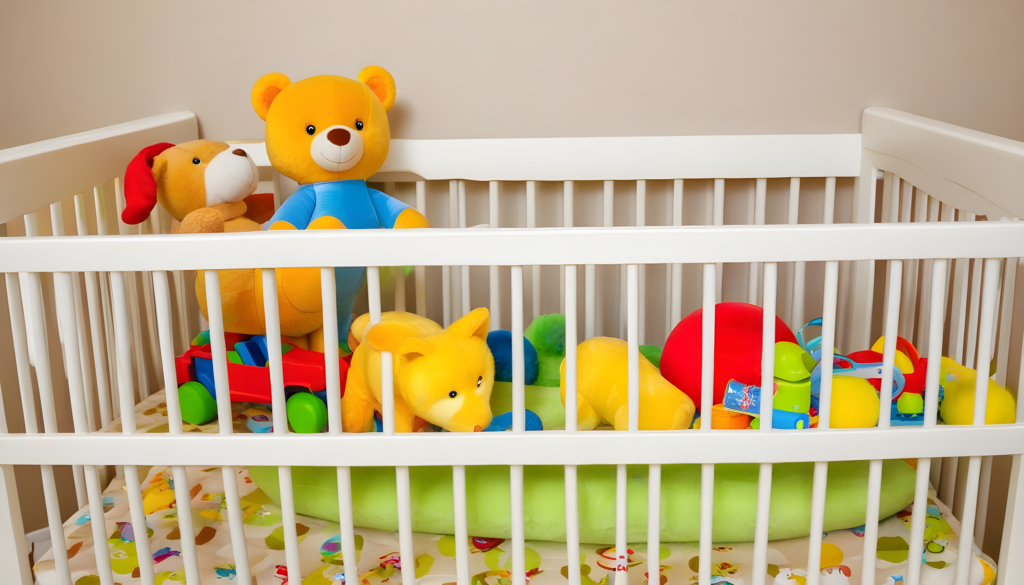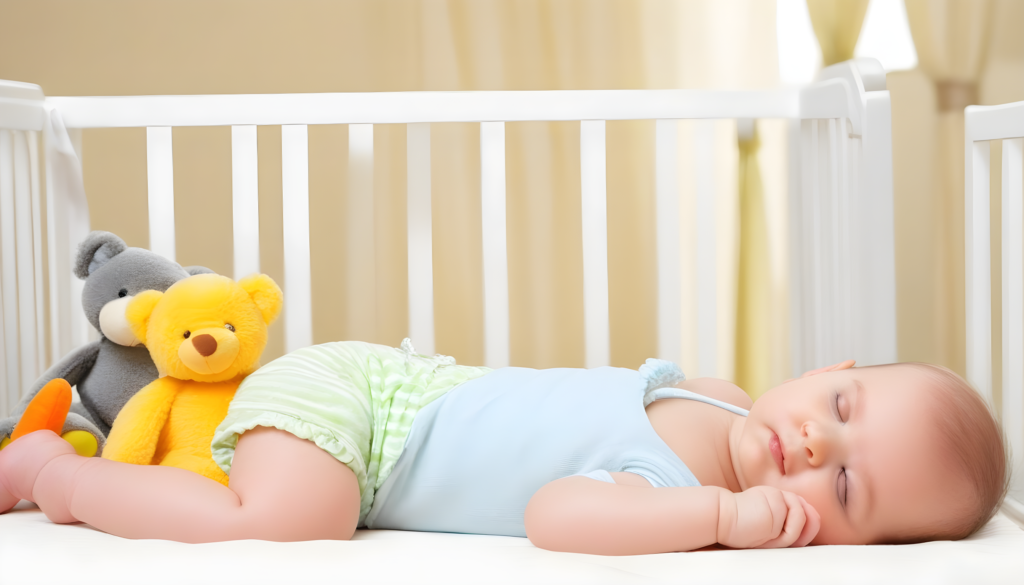
When can you put toys in the crib?
It is generally recommended to introduce toys in the crib when your baby reaches around 4 to 6 months of age. At this stage, babies have better head control and are more alert, making it safer for them to interact with toys during their waking hours.
Before the age of 4 months, babies may have limited control over their movements and may not be able to remove toys that accidentally come into contact with their faces, posing a potential suffocation risk. However, once they develop better motor skills and can roll over or move their head freely, the risk decreases.
The timing of when to put toys in the crib depends on the developmental stage and safety guidelines. It is generally recommended to avoid placing toys in the crib during the first year to reduce the risk of suffocation or other safety hazards. However, as the child grows older and reaches certain milestones, introducing soft, age-appropriate toys can have benefits for their development and comfort.
During the first year, it is essential to prioritize safety by keeping the crib free of any loose objects, including toys. Infants have limited mobility and may accidentally cover their face with toys or become entangled, posing a suffocation risk. To create a safe sleep environment, it is best to use a firm mattress with a fitted sheet and keep the crib free from pillows, blankets, and stuffed animals.
As the child becomes more mobile and starts to develop fine motor skills, around the age of one or when they are able to sit up unassisted, you can gradually introduce soft toys to the crib. It is important to choose toys specifically designed for infants and ensure they are age-appropriate, free from small parts that can be swallowed or pose a choking hazard. Soft, plush toys without hard components or strings are generally safer options.
What age can my baby sleep with a stuffed animal?
The age at which a baby can sleep with a stuffed animal varies and depends on several factors, including safety guidelines and individual development. Generally, it is recommended to wait until around 12 months of age before introducing a stuffed animal into the baby’s sleep environment.
During the first year, it is important to prioritize safe sleep practices and minimize the risk of suffocation or other hazards. Infants have limited mobility and may not have the motor skills or coordination to move objects away from their face if they become tangled or obstructed. Therefore, it is generally advised to keep the crib free from stuffed animals, pillows, blankets, or any other loose items.
Each child develops at their own pace, so it is essential to assess your baby’s readiness and monitor their sleep habits and behavior. Some babies may show an attachment to a stuffed animal earlier, while others may take longer. Always prioritize safety, supervise your baby during sleep, and regularly inspect the stuffed animal for any signs of wear or damage.
Remember to consult with your pediatrician for personalized advice based on your baby’s specific needs and development.
When are stuffed animals safe in the crib?

Stuffed animals are generally considered safe in the crib once your baby is able to sit up unassisted, around 6 to 8 months of age. At this stage, babies have better control over their body movements and can adjust their position to maintain a clear airway.
As your baby gains more physical independence and can sit up without support, the risk of suffocation decreases significantly. It is still important, however, to ensure that the stuffed animals in the crib are free from small parts or loose attachments that could pose a choking hazard.
Is it safe to keep old stuffed animals?
The safety of old stuffed animals depends on their condition. If the stuffed animals are in good condition, free from loose parts or damage, they can be safe for your child to play with. However, it is essential to regularly inspect and clean them to maintain their safety.
Over time, stuffed animals can accumulate dust, dirt, and allergens, which may pose health risks to your child, particularly if they have allergies or asthma. Regularly wash and inspect the old stuffed animals for any signs of wear, loose stitching, or damaged components. If you notice any concerns, it’s best to replace them with new ones to ensure your child’s safety.
How can toys in the crib contribute to a child’s development and learning?

Toys in the crib can play a significant role in promoting your child’s development and learning. They stimulate the senses, encourage exploration, and foster cognitive and motor skill development.
Age-appropriate toys in the crib can engage your baby’s senses and encourage them to reach, grasp, and manipulate objects. Toys with contrasting colors, different textures, and sounds can enhance sensory development. Interactive toys promote cognitive skills, problem-solving abilities, and hand-eye coordination. Furthermore, toys that require manipulation can assist in developing fine motor skills and strengthening hand muscles.
What are the potential hazards to consider when introducing stuffed animals to the crib?
When introducing stuffed animals to the crib, it’s essential to be aware of potential hazards such as suffocation, choking, and allergens. Avoid placing large or bulky stuffed animals that could obstruct your baby’s breathing or cover their face. Additionally, ensure that the stuffed animals don’t have loose parts or small accessories that can pose a choking hazard.
Soft and plush stuffed animals can accidentally cover a baby’s face, potentially obstructing their airway and increasing the risk of suffocation. Always choose stuffed animals that are proportionate to your baby’s size, and avoid overly large ones that can interfere with their breathing. Moreover, inspect the stuffed animals regularly to ensure that they remain intact and do not have any loose parts or small attachments that can detach and pose a choking hazard.
Are there any specific guidelines for choosing safe and age-appropriate toys for the crib?
When selecting toys for the crib, there are guidelines to consider ensuring safety and age appropriateness. Look for toys that are specifically designed for infants, free from small parts or detachable components, and made from non-toxic materials. Toys with rounded edges, smooth surfaces, and securely attached parts are generally safer for babies to play with in the crib.
Always prioritize safety when choosing toys for the crib. Check the packaging or labels for age recommendations provided by the manufacturer. Ensure the toys are free from small parts, buttons, or any loose attachments that could pose a choking hazard. Opt for toys made from non-toxic materials and avoid toys with sharp edges or rough surfaces that could potentially harm your baby. Following these guidelines will help ensure that the toys in the crib are safe and appropriate for your child’s age and developmental stage.
How can you create a stimulating and safe sleep environment with toys and stuffed animals?

To create a stimulating and safe sleep environment with toys and stuffed animals, it’s important to strike a balance. Limit the number of toys in the crib to avoid clutter and potential hazards. Choose age-appropriate toys that encourage sensory exploration, cognitive development, and fine motor skills. Ensure that all toys and stuffed animals are securely attached to the crib and regularly inspect them for any signs of wear or damage.
Having a few carefully selected toys in the crib can contribute to a stimulating sleep environment. Choose toys that engage your baby’s senses, such as soft rattles, textured toys, or toys that make gentle sounds. Avoid overcrowding the crib to minimize potential hazards and promote better sleep. Additionally, ensure that all toys and stuffed animals are securely attached to the crib or within reach of your baby but out of their sleeping area. Regularly inspect the toys for wear and tear, loose stitching, or damaged parts, and promptly replace any items that show signs of deterioration to maintain a safe sleep environment.
What are some alternative ways to repurpose or donate old stuffed animals instead of keeping them?
If you no longer wish to keep old stuffed animals, there are alternative ways to repurpose or donate them. Consider repurposing them as decorative items in your child’s room, donating them to charitable organizations, or giving them to friends or family members who may have younger children.
If your child has outgrown their old stuffed animals or you simply want to declutter, repurposing them as decorative items can add a touch of nostalgia to your child’s room. They can be placed on shelves or displayed in a special corner. Alternatively, consider donating them to local charities, hospitals, or shelters that accept gently used toys. This way, your old stuffed animals can bring joy to other children in need. You can also offer them to friends or family members who have younger children and would appreciate a new cuddly companion.
Creating a safe and stimulating sleep environment for your baby involves careful consideration of toys and stuffed animals in the crib. By adhering to safety guidelines, choosing age-appropriate toys, and regularly inspecting them for any potential hazards, you can provide your baby with a secure and enriching sleep environment. Additionally, repurposing or donating old stuffed animals allows for sustainable practices while bringing joy to others.

